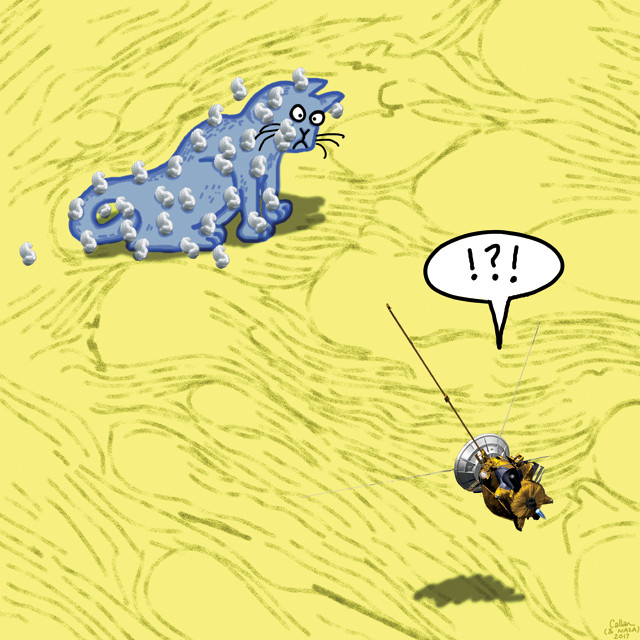
by Mary Caperton Morton Wednesday, July 19, 2017

Titan's electrostatically sticky sands could be problematic if we try to land a spacecat — er, spacecraft — on the Saturnian moon. Credit: Callan Bentley, 2017.
Saturn’s largest moon, Titan, which has a dense, nitrogen-rich atmosphere with evidence of large amounts of frozen water at the surface, is a world apart from Earth’s moon. Among other strange phenomena, Titan has vast fields of frozen hydrocarbon particles that form 100-meter-tall dunes whose crests point east, opposite the prevailing west-blowing winds predicted by atmospheric models of Titan. In a new study in Nature Geoscience, researchers have found that these mysterious dunes may be sculpted in part by electrostatic charging of the frozen hydrocarbon grains.
On Earth, friction between blowing ash or sand can lead to electrostatic charging of the particles, causing them to clump together, much the same way that bits of Styrofoam do. Gravity is usually strong enough to overcome this electrostatic attraction and the charging tends to dissipate quickly, so electrostatics seldom affect the shape of dunes on Earth. However, this phenomenon, also known as triboelectric charging, could play a role in sculpting Titan’s unusual dune fields because gravity on Titan is weaker than on Earth and the hydrocarbon particles can retain a charge for much longer.
Joshua Méndez Harper of Georgia Tech and colleagues simulated some of Titan’s unique atmospheric conditions in the lab. When they tumbled a mixture of hydrocarbon particles through a nitrogen-filled, hydrocarbon-coated tube, they found that the particles became charged and started clumping together as they rubbed against one another. Although the experiments were done at room temperature, not at Titan’s minus 179 degrees Celsius, the results suggested that triboelectric charging and attraction on Titan might be much more powerful than it typically is on Earth, according to the researchers. This charging “makes the grains so sticky and cohesive that only heavy winds can move them. The prevailing winds [on Saturn] aren’t strong enough to shape the dunes,” Méndez Harper said in a statement.
The findings could be important for future missions to Titan, because strongly charged particles on the moon’s surface could interfere with a lander’s functioning. “Any spacecraft that lands in regions of granular material on Titan is going to have a tough time staying clean. Think of putting a cat in a box of packing peanuts,” said co-author Josef Dufek, also of Georgia Tech.
© 2008-2021. All rights reserved. Any copying, redistribution or retransmission of any of the contents of this service without the expressed written permission of the American Geosciences Institute is expressly prohibited. Click here for all copyright requests.